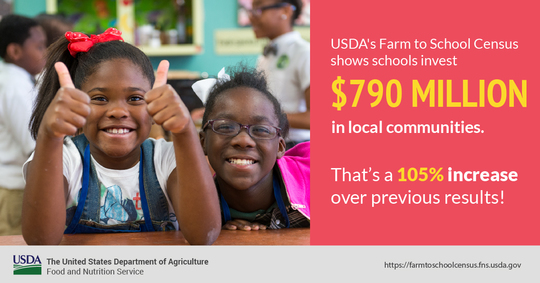|
Throughout October, we've worked alongside the National Farm to
School Network to encourage our partners to take one small step to get
informed, get involved, and take action to advance farm to school in
their own communities and across the country. Digging into the Census data is one small, easy step you can take today!
 Earlier this year, the U.S. Department of Agriculture (USDA) released final results from the 2015 USDA Farm to School Census, showing that more than 42,000 schools
across the country are operating farm to school programs and another
10,000 have plans to start in the future. During the 2013-2014 school
year, these schools purchased nearly $800 million worth
of local products from farmers, ranchers, fishermen and other food
producers – a 105 percent increase from the 2011-2012 school year – and
tended to more than 7,101 school gardens.
The Farm to School Census establishes a national baseline of farm to
school activities happening across the country. Whether you’re
interested in learning about the national landscape, what’s happening in
your state or how your school district participates in farm to school,
there are many ways that this information can be used to support your
farm to school efforts. Here are three small steps you can take for
using Census data to strengthen farm to school activities in your
community:
 1. Use Farm to School Census data when sharing your story
The Farm to School Census contains data about farm to school
activities at the local, state and national levels. Using this data –
such as the number of kids impacted by farm to school programs or the
dollars spent on local food by schools – can help decision makers
understand the benefits farm to school programs have for kids, farmers
and communities. Combining validated USDA numbers with your personal
experiences and stories can be a powerful tool for raising awareness and
spreading your message.
|
 2. Use Farm to School Census data to guide training and technical assistance efforts
The Census includes information on schools that report wanting
to start farm to school activities, as well as challenges school report
facing when it comes to buying local foods. It also shows which local
foods schools are currently purchasing and which they would like to
purchase in the future. Knowing this information allows support service
providers to help schools get involved in farm to school and assist
their expansion of farm to school efforts. Use the Farm to School Census data explorer to download information on the kinds of training and technical assistance schools in your area need most.
|
 3. Use Farm to School Census data to measure progress
Track the progress of farm to school activities in your district or state by downloading raw data
from both the 2013 and 2015 Farm to School Census. This raw data
provides information to track farm to school participation, dollars
spent on local foods, and the number of school gardens throughout each
state. Comparisons can be made locally, statewide or nationally. Some
states, such as Oregon, have begun to use Census data to create statewide goals and action plans. Regional groups, such as Farm to Institution New England (FINE), are also using Census data to measure progress across multiple states.
Explore more ideas for using Census data by watching a recording of the 2015 Farm to School Census webinar, co-hosted by USDA and the National Farm to School Network in August.
|

|
Call for Stories: Serving Local Traditional Foods
In honor of Native American
Heritage Month, we are collecting success stories about
incorporating local traditional foods into the child nutrition programs. Do you
have a story to share? Use the link below to tell us your story, and be sure
to include any photos!
|
|
 |


By Lindsay Williams and Blair Tucker-Gruchala, Food Distribution Division, USDA Food and Nutrition Service
What do the military’s logistical network, peaches and peppers, and
school children have in common? The first delivers the second to the
third through a unique partnership between the Department of Defense
(DoD) and USDA.
October is National Farm to School Month and the perfect time to celebrate the DoD Fresh Fruit and Vegetable Program, which connects schools with fresh and often local produce using their USDA Foods entitlement dollars. Schools order local foods from a variety of sources, and according to the 2015 USDA Farm to School Census, 29 percent of districts participating in farm to school are receiving local foods through DoD Fresh.
|

|